 |
 |
||||||
 |
|||||||
Quasi Cinema is a term that Brazilian artist Helio Oiticica coined in 1973 in reference to his experiments with film, slide projections, and new modes of cinematic reception. His ongoing series pursued the challenging attempt to distill the essence of cinema into a cinematic imaginary. The featured works in this exhibition are taking this concept as the outset for new arguments - some express this concept in media other than that of cinema itself, others re-appropropriate and "misuse" the primary functionality (and inherent poetics) of film projection.
With respectful reference to (and inspired by) two exhibition cycles with the same title by curators Berta Sichel (formerly Museo Reina Sofia, Madrid) and Eva de Groote (Vooruit, Ghent).
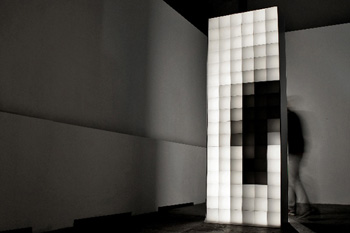
0,16 is a light installation in which the shadows of a passer-by is transformed into 'pixels'. The installation consists of a wall built of small square frames covered front and back with transparent paper. A third layer of paper is attached in the centre of the frames. A lamp shining at a distance breaks the shadows of the passers-by into squares, allowing a pixellated human figure to be seen on the other site of the installation. In this simple way, Bartholl renders tangible the pixels found in the world of digital communications.The 'resolution' of the screen is 0,16 ppi (pixels per inch), hence the title.
[more]
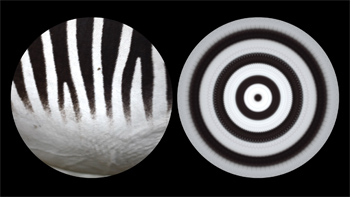
On the right, the same sequence is digitally refracted as through a prism, splintered into a breathtakingly gorgeous abstract pattern that evokes a superfine kaleidoscope or rose window. […]
The transformation, while purely technical, creates the illusion of seeing through to some underlying layer of natural beauty and order. Nature is devoid of ugliness, these works seem to say. As if to prove the point, the final work here is a film of a dead baby bird whose head is teeming with maggots, presented on its own, straight up, without the benefit of the digital prism. - Roberta Smith, NY Times.
[more]
image courtesy of Winkleman Gallery, NY
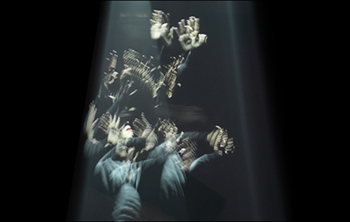
"Luzes relacionais" (Relational Lights) is an interactive audio-visual installation that explores our relationship with the expressional-organic character of space. The installation uses light, sound, haze, and a custom-software system to create a morphing, three-dimensional light-space in which spectators actively participate, manipulating it with their presence and movements. The work functions as a living organism with or without the presence and interactions of spectators. When viewers step outside the projected light-space, the system begins its own dialogue with space by means of extruding and morphing sequences of geometric light forms. And when viewers penetrate and interact with the projected light-space, a collective and participatory expression of space unfolds. "Luzes relacionais" amplifies the three-dimensional fabric of space by making it visible, audible, and tangible to participants. The resulting aesthetic experience encourages an unending relational process of shaping space among participants. "Luzes relacionais" is a hommage to the work and aesthetic inquiry of Brazilian artist Lygia Clark.
[more]
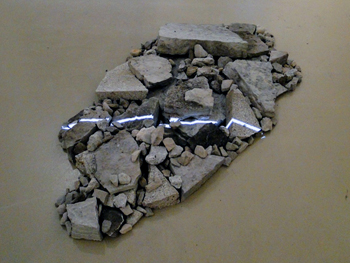
A single white line of video light moves slowly over a pile of stones and debris. It is unclear to the viewer whether the pile is made from the raw materials for future building, or if it is the remains of a demolition or a structure's decay. Whether pre- or post-construction, the pile represents a position near the bottom of the arc of becoming: an entropic assembly of material either to be composed or decomposing. Across this, the white line of light cuts a kind of index mark, a way of traversing the material's topography in time.
The line of light operates dually, at once "playing" the rough material texture and form that it glides across (as if it were the long white cursor ubiquitous in audio software interfaces), while simultaneously being deformed by that very material texture and form. And this dual functioning of the line reflects itself back upon the material it describes: if the line is a cursor, the pile becomes the elements of a composition-in-process, while if the light forms a line of topography, the pile is its landscape, its given environment.
[more]
CORNER PROJECTION SERIES NO. 6
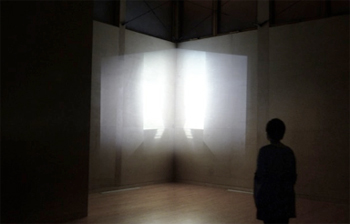
Taurushi's corner projections are architectural interventions, provoking the simultaneous collapse of interior and exterior, of positive and negative corner space.
"Video projections build durational architecture in space. Projected visual movement regulates patterns of luminosity. By increasing or diminishing it, space itself can be reflected or diffused. This visual composition also can be collapsed by a sudden pause or darkness of the projection. It is a second that detaches one from things one perceives." (N.T.)
[more]
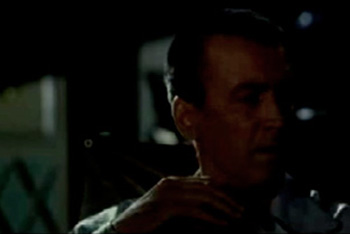
"Movie Mirrors" consists of a computer, monitor, a webcam and custom software. The viewer sees his or her mirror image being switched back and forth to characters from movie images surrounded by their scene. The viewer's face is captured in real time; its size and location on the screen is determined and matched to a series of images stored in a database. The first version, "Movie Mirrors I: Trailers" uses 2500+ images from recent movie trailers.
[more]
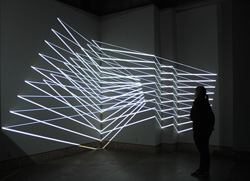
Nervous Structure is a series of site-specific, interactive installations consisting of string and fabric structures illuminated with interactive computer graphics that react to the presence and motion of viewers.
Made collaboratively by Annica Cuppetelli and Cristobal Mendoza.
[more]
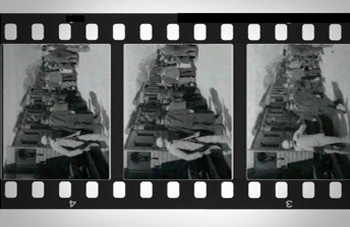
"Festoon" is an early cine-installation in which ingenious avant-garde film maker Jacobs let the viewer to see several upright 35mm frames from the Brother Lumiere's proto-film "Arrival of the Traian at La Ciotat" (1895) in 3D. Viewers are encouraged to slide the film strip through a handheld stereoscopic viewer, always watching two frames at a time.
[NYT on Ken Jacobs]
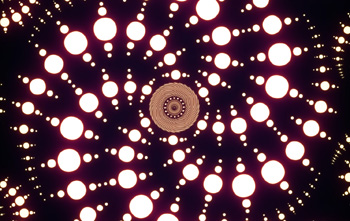
A circular looping animation projection installation.
"(...) the film is based on the idea that there is an underlying unchanging synchronisation at the centre of everything; a sync that was decided at the very beginning of time. Everything follows from it, everything is ruled by it: all time, all physics, all life. And all animation." (Max Hattler)
[more]
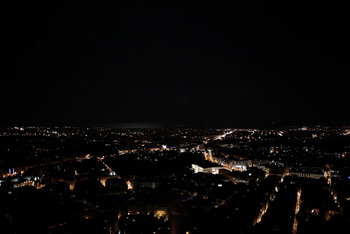
"Niklas Goldbachs TEN (2010) is an allegory of the intransparency of the power elite. The gathering of a group of ten men, taking decisions over fate and doom in ambiguous rituals, oscillates between dystopic fiction and a relentless survey: freed from emotions or distinctions, the Ten, all of them one and the same person, are trapped between elite representational behavior and lethargic activities. The view behind the scenes of a summit meeting on a stage of a sterile and de-individualized luxurious suite including the tableaus of Athens by night, anticipates a climax of a fragile system of power, ultimately trying to preserve itself through the performance of its own iconography and traditional allocation of roles."
(Viktor Neumann)
[more]